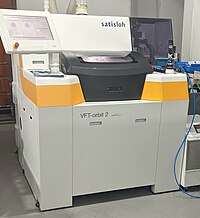History of optics

Okay kiddo, let's talk about the history of optics!
Optics is the science of how we see things. It's all about the way that light moves and interacts with objects. People have been trying to understand optics for thousands of years!
One of the earliest people to study optics was a guy named Euclid, who lived in Greece a long time ago. He wrote a book called "Optics" that talked about how light travels in straight lines.
Later, in the 10th century, a man named Alhazen, who was from Persia, did experiments to test Euclid's ideas about light. He discovered that the angle that light hits a mirror affects how it reflects back. He also found out that our eyes see things because light travels into our eyes and hits the back of them.
Around the same time, people started making glasses to help them see better. It's not clear who exactly invented glasses, but they became popular in Italy in the 13th century. At first, glasses were just made of round pieces of glass that were used to magnify things, but eventually people figured out how to grind lenses into different shapes to help people see better from different distances.
In the 16th and 17th centuries, a lot of really important discoveries were made in optics. One of the most famous scientists from this time was Isaac Newton. He discovered that light is made up of different colors (like a rainbow) and that a prism can separate these colors out. He also invented the reflecting telescope, which uses mirrors to gather and focus light.
In the 19th century, people started using lenses to make cameras and microscopes. These tools allowed us to see things that were too small or too far away for our eyes to see on their own.
Today, we use optics in all sorts of ways to help us see and communicate. We use fiber optics to send information through cables, and telescopes to look at distant galaxies. It's pretty amazing how much we've learned about how light works over the years!
Optics is the science of how we see things. It's all about the way that light moves and interacts with objects. People have been trying to understand optics for thousands of years!
One of the earliest people to study optics was a guy named Euclid, who lived in Greece a long time ago. He wrote a book called "Optics" that talked about how light travels in straight lines.
Later, in the 10th century, a man named Alhazen, who was from Persia, did experiments to test Euclid's ideas about light. He discovered that the angle that light hits a mirror affects how it reflects back. He also found out that our eyes see things because light travels into our eyes and hits the back of them.
Around the same time, people started making glasses to help them see better. It's not clear who exactly invented glasses, but they became popular in Italy in the 13th century. At first, glasses were just made of round pieces of glass that were used to magnify things, but eventually people figured out how to grind lenses into different shapes to help people see better from different distances.
In the 16th and 17th centuries, a lot of really important discoveries were made in optics. One of the most famous scientists from this time was Isaac Newton. He discovered that light is made up of different colors (like a rainbow) and that a prism can separate these colors out. He also invented the reflecting telescope, which uses mirrors to gather and focus light.
In the 19th century, people started using lenses to make cameras and microscopes. These tools allowed us to see things that were too small or too far away for our eyes to see on their own.
Today, we use optics in all sorts of ways to help us see and communicate. We use fiber optics to send information through cables, and telescopes to look at distant galaxies. It's pretty amazing how much we've learned about how light works over the years!
Related topics others have asked about:
